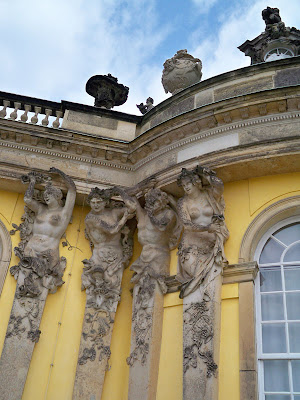So Tuesday we got going early; 8:00AM. Had to get the students together, get to the train station, get our tickets, and then 45 minutes to Potsdam. There are several historic places and buildings to see there, and we walked (and walked... and walked...) them all.
The first sight greeting us when leaving Potsdam Hauptbahnhof is the dome of the Nikolaikirche in the distance.
We walked over the bridge to see it closer.
Like many historic places in Europe, there always seems to be some scaffolding somewhere, keeping up and repairing is a full time task.
The interior of the church is quite stunning. My camera cannot capture what my eye sees at it moves about the space.
From here we walked through the city to their Brandenberg Gate. While not as large and well-known as Berlin's it nonetheless anchors an axis through the city, along which the students ate and shopped a bit.
Now it was time for the main gardens and palaces. The Sanssouci Gardens are enormous, with three different palaces, stables, a large windmill, and plenty of follies and ancillary buildings. The first we experienced is the main and first built; the Sanssouci Palace, in full yellow Baroque.
Those are a lot of stairs. The problem with palaces, I have found, is that the king naturally wants the best views, so they are always up on hills with lots of grand stairs and such. I am not in shape for this, but the students seem fine. And I will admit, the view is a good one.
Plenty of pilasters transforming into people.
and a view of the courtyard.
Also in the gardens, a little bit further, is a much later palace (1864) the "Orangerie."
Unlike its Baroque predecessor, this is in a stripped-down Neoclassical style that hints at the Modern Movement to come in a few decades.
We did not make it all the way down to the New Palace, clear on the other end of the gardens. These gardens are massive! It's good to be Emperor.
We did travel by bus to the other side of Potsdam, to a different palace and Garden. The Babelsberg Palace is set high in a heavily wooded garden, which we had to walk through because I misread the bus map. It did afford a wonderful chance to come upon the building from behind.
This is the front. The palace was actually built in two parts. The front half is by Karl Schinkel, and is in a Neo-gothic style he was interested in at the time. The palace was for a brother, and so was smaller. But when later He became a prince next in line to the throne, his wife had the palace extended, in the Romantic style more to her taste (and causing Schinkel to disavow the whole project). I hope the students begin to understand that, while it all looks "old" and "historical" to us now, these various styles had real political and cultural meaning and differences at the time, and that every style in new at some point. Mental food for later thought when we go to more contemporary buildings again.
Wednesday, June 16, 2010
Subscribe to:
Post Comments (Atom)














No comments:
Post a Comment